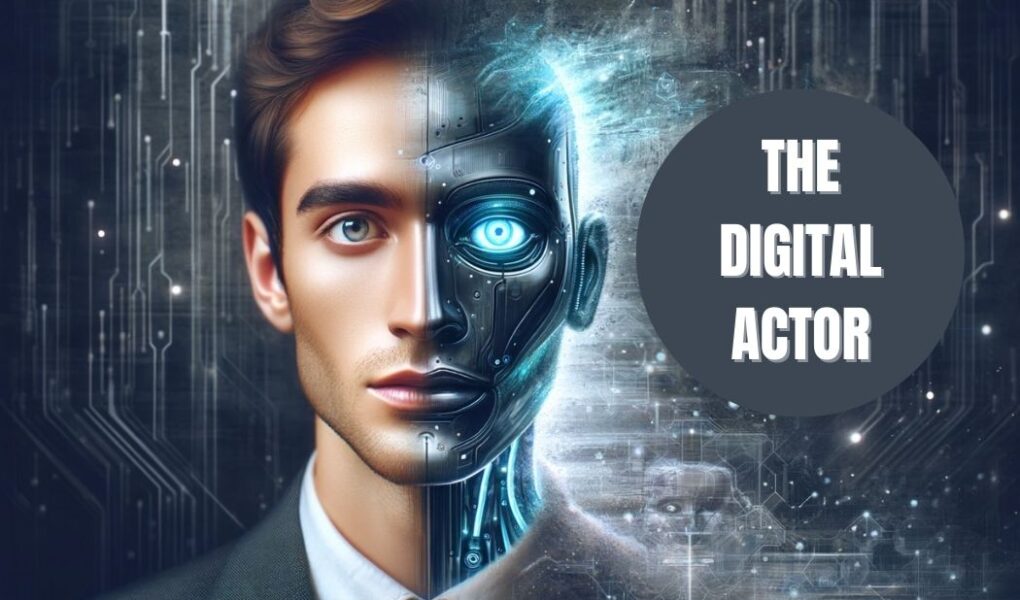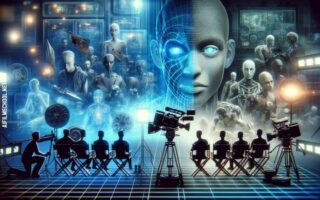At a time where technology continues to reshape our lives in unprecedented ways, it should come as no surprise that the world of entertainment is also undergoing a significant transformation.
One of the most intriguing developments in this regard is the emergence of the “Digital Actor” – a term used to describe the fusion of artificial intelligence (AI) and performance art.
In this blog post, we will delve deep into the world of the Digital Actor, exploring how AI is revolutionizing the future of performance.
The Rise of the Digital Actor
Traditionally, when we think of actors, we envision individuals who bring characters to life on stage or screen through their talent and training. These actors undergo extensive rehearsals, memorize lines, and pour their emotions into their roles to create a compelling performance.
However, with the advent of AI, the landscape is evolving, and we are witnessing the rise of the Digital Actor.
What is a Digital Actor?
A Digital Actor is an AI-powered entity capable of mimicking human emotions, expressions, and behaviours. It can take on a role in a play, film, or any other form of entertainment, providing an alternative to human actors.
By harnessing the power of machine learning and deep neural networks, these digital performers are becoming increasingly convincing and versatile.
The Technology Behind the Digital Actor
Natural Language Processing (NLP)
One of the key technologies that empower Digital Actors is Natural Language Processing (NLP). NLP allows AI systems to understand and generate human language, making it possible for these digital performers to deliver lines of dialogue that sound natural and emotionally resonant.
Through NLP, AI can also analyze scripts and provide valuable insights to directors and writers.
Computer Vision
Computer Vision is another crucial component in the arsenal of a Digital Actor. This technology enables AI to recognize facial expressions, body language, and gestures, allowing the digital performer to convey a wide range of emotions and reactions. It ensures that the AI-driven character can express joy, sorrow, anger, and everything in between with remarkable precision.
Generative Adversarial Networks (GANs)
Generative Adversarial Networks (GANs) play a pivotal role in creating realistic digital actors. GANs consist of two neural networks – a generator and a discriminator – that compete against each other. The generator creates images or animations, while the discriminator tries to distinguish them from real ones. This adversarial process results in the generation of highly convincing visuals for the digital actor.
The Benefits of Digital Actors
1. Versatility
One of the most significant advantages of Digital Actors is their versatility. They can effortlessly switch between roles and characters without the need for physical transformations or costume changes. This flexibility allows for faster production and opens up a world of creative possibilities.
2. Consistency
Digital Actors are immune to the fluctuations in human performance caused by fatigue, mood swings, or external factors. They can deliver consistent performances throughout long shooting days or stage productions, ensuring a higher level of quality and continuity.
3. Cost Efficiency
Hiring and managing human actors can be a costly endeavour. Digital Actors offer a cost-effective alternative, as they do not require salaries, accommodation, or insurance. Once developed, a Digital Actor can be used across multiple projects without additional expenses.
4. Risk Reduction
Human actors can sometimes face health issues, schedule conflicts, or other unexpected challenges that disrupt production schedules. Digital Actors eliminate these risks, providing a reliable and predictable presence on set or stage.
5. Preservation of Talent
Digital Actors can be created to emulate legendary actors, preserving their performances for future generations. Imagine being able to see a new film starring Humphrey Bogart or Marilyn Monroe, thanks to the magic of AI.
Challenges and Ethical Considerations
While the potential of Digital Actors is undeniable, their rise is not without its challenges and ethical dilemmas.
1. Job Displacement
The integration of Digital Actors into the entertainment industry raises concerns about the future of human actors and various other professionals who contribute to the creation of films, theater productions, and television shows. Here are some key points to consider:
a. Impact on Human Actors:
- Reduced Opportunities: As Digital Actors become more sophisticated and versatile, there may be a decrease in the demand for human actors, especially for roles that can be effectively portrayed by AI-driven characters. Casting choices may shift in favor of Digital Actors due to their cost-efficiency and consistency.
- Typecasting and Stereotyping: Digital Actors may be used to perpetuate stereotypes or fulfill specific roles that could have a negative impact on diversity and representation in the industry. Human actors who belong to underrepresented groups may find it even more challenging to secure meaningful roles.
b. Impact on Makeup and Costume Artists:
- Reduced Workload: The need for extensive makeup and costume design for actors could diminish with Digital Actors, who do not require physical transformations. Makeup artists and costume designers might see a decrease in demand for their services, particularly for characters that can be entirely digitally generated.
c. Impact on Stunt Performers:
- Safety Concerns: Stunt performers often play a critical role in action-packed scenes, where their physical skills and expertise are essential. While Digital Actors can replicate many movements, there are still safety concerns in using AI to perform physically demanding stunts. However, for less hazardous stunts, AI-driven characters might be used, reducing opportunities for stunt performers.
d. Impact on Voice Actors:
- Voice Emulation: Digital Actors are not limited to visual performances. AI can also mimic human voices convincingly. This may affect voice actors who provide dubbing, voiceovers, or character voices in animation and gaming. Digital Actors can be programmed to speak in various languages and styles, potentially reducing the need for human voice talent.
e. Impact on Supporting Roles:
- Secondary Characters: Supporting roles in productions might be filled with Digital Actors, particularly when these roles don’t require extensive character development or unique human qualities. Human actors may find themselves competing with AI for these roles.
f. Impact on Extras and Background Actors:
- Crowd Scenes: In large-scale productions that require numerous extras or background actors for crowd scenes, Digital Actors can efficiently replicate the appearance of a crowd. This could reduce the demand for extras in certain situations.
g. Impact on Industry Professionals:
- Writers and Directors: Writers and directors may need to adapt their creative processes when working with Digital Actors. While AI can assist with generating dialogue and providing creative suggestions, some industry professionals may feel that their roles are threatened by the increasing automation of creative tasks.
While Digital Actors offer benefits such as versatility and cost-efficiency, the potential job displacement within the entertainment industry is a significant concern. Striking a balance between the use of Digital Actors and preserving opportunities for human actors and industry professionals will be a complex challenge for the entertainment industry as it navigates this digital revolution.
Clear ethical guidelines and thoughtful consideration of the impact on job markets will be essential as the industry moves forward into this new era of performance art.
2. Loss of Authenticity
One of the primary concerns with the emergence of Digital Actors is the potential loss of authenticity in performances. Authenticity in acting is deeply rooted in the emotions, experiences, and unique qualities that human actors bring to their roles. Here are some key points to consider:
a. Emotional Depth:
- Human Emotions vs. Algorithmic Expressions: Human actors have the ability to draw from their own emotions and experiences, allowing them to convey complex feelings and reactions in a genuine and relatable manner. They can tap into their personal experiences to bring authenticity to their performances, something that Digital Actors, driven by algorithms, may struggle to replicate fully.
- Subtlety and Nuance: Human actors excel in portraying subtle emotions and nuances that are challenging for AI to capture. The micro-expressions, hesitation, and unpredictability of human performances contribute to the authenticity of a character.
b. Connection with the Audience:
- Empathy and Relatability: Human actors often create a strong connection with the audience because they can convey relatable human experiences. The authenticity of their performances allows viewers to empathize with characters and feel a genuine emotional connection.
c. Unique Human Qualities:
- Imperfections and Uniqueness: Imperfections and idiosyncrasies are part of what makes human performances authentic. These quirks and imperfections make characters feel real and relatable. Digital Actors, on the other hand, may lack these unique human qualities.
- Character Diversity: The diverse backgrounds, experiences, and personalities of human actors contribute to the richness and authenticity of the characters they portray. Digital Actors may struggle to capture this diversity effectively.
d. Adaptation to Unforeseen Circumstances:
- Adapting to Challenges: Human actors have the ability to adapt to unforeseen circumstances, such as unexpected weather conditions during outdoor shoots or technical glitches on stage. They can improvise and continue the performance seamlessly, which may be challenging for Digital Actors.
e. Creative Interpretation:
- Artistic Interpretation: Human actors often bring their unique artistic interpretation to their roles. They collaborate with directors, fellow actors, and writers to create a character that is multidimensional and nuanced. Digital Actors may lack the ability to provide this level of creative input.
f. Ethical Considerations:
- Authenticity in Historical and Biographical Roles: When portraying real historical figures or individuals with specific cultural backgrounds, authenticity becomes a critical concern. AI-driven performances may struggle to capture the authenticity required for these roles, potentially leading to controversies and backlash.
3. Privacy Concerns
The integration of artificial intelligence (AI) and Digital Actors into the entertainment industry brings forth several privacy concerns, both for the individuals involved in the creation of these actors and for the audiences consuming the content. Here are some key points to consider:
a. Data Collection:
- Facial Recognition: To create convincing Digital Actors, AI often relies on facial recognition technology to capture the expressions and movements of human actors. This involves collecting detailed facial data, including expressions, gestures, and even biometric information.
- Motion Tracking: In addition to facial data, motion tracking technology may be used to record the movements of human actors. This includes capturing body language and physical gestures. These data points are essential for recreating realistic performances.
b. Consent and Privacy Rights:
- Lack of Informed Consent: In some cases, individuals whose likeness is used for Digital Actors may not have provided informed consent for the collection and use of their facial and motion data. This raises ethical concerns about the potential misuse of personal information.
- Privacy Violations: The use of AI-driven characters that closely resemble real people can lead to privacy violations, as individuals may feel that their likeness has been exploited without their consent.
c. Deepfakes and Misuse:
- Deepfake Technology: Deepfake technology, a subset of AI, can manipulate and superimpose faces onto other bodies, leading to the creation of realistic but entirely fabricated content. This technology has been misused for creating non-consensual adult content and spreading false information.
- Impersonation: Digital Actors created through deepfake technology could impersonate real individuals convincingly, potentially leading to identity theft or character defamation.
d. Security Breaches:
- Data Security: Storing large amounts of facial and motion data for the creation of Digital Actors poses security risks. If this data is not adequately protected, it could be vulnerable to breaches and cyberattacks.
e. Public Figures and Celebrities:
- Targeting Public Figures: Public figures, including celebrities and politicians, are often the subjects of Digital Actors. The use of their likeness in AI-generated content can lead to privacy concerns and ethical debates, as they may have limited control over how their image is used.
f. Consent Challenges:
- Posthumous Use: The posthumous use of a celebrity’s likeness for Digital Actors raises unique consent challenges. It may be difficult to obtain consent from the estates or families of deceased individuals, leading to potential legal and ethical dilemmas.
g. Ethical Guidelines:
- Need for Ethical Guidelines: The entertainment industry and AI developers need to establish clear ethical guidelines for the collection, storage, and use of personal data in the creation of Digital Actors. These guidelines should prioritize consent, transparency, and the protection of individuals’ privacy rights.
h. Regulatory Measures:
- Government Regulations: Governments may need to enact regulations that govern the use of AI and Digital Actors in the entertainment industry to protect individuals’ privacy and ensure responsible data handling practices.
4. Creative Control
The introduction of Digital Actors into the world of entertainment raises complex questions regarding creative control. Filmmakers, writers, directors, and producers must navigate the balance between harnessing the capabilities of AI-driven characters and maintaining creative control over their projects. Here are key points to consider:
a. Collaboration vs. Automation:
- Creative Collaboration: The use of Digital Actors can be seen as a form of creative collaboration. Filmmakers and writers can work with AI to develop characters, generate dialogue, and explore new storytelling possibilities. AI can be a valuable tool for brainstorming and generating ideas.
- Automation: However, there is a risk that too much reliance on AI may lead to a sense of automation in the creative process. Some worry that AI-driven characters could replace the need for human creativity, diminishing the role of artists in shaping the narrative.
b. Scriptwriting and Dialogue Generation:
- Assistance in Scriptwriting: AI can assist in scriptwriting by analyzing trends, suggesting plot twists, and even generating dialogue. This can be a valuable resource for writers seeking inspiration or efficiency in their work.
- Preserving Creative Vision: Writers and directors may need to strike a balance between utilizing AI-generated content and preserving their unique creative vision. Maintaining control over the narrative direction and character development remains crucial for ensuring the authenticity and impact of a story.
c. Directorial Influence:
- Director’s Vision: Directors play a pivotal role in shaping the visual and emotional aspects of a production. While Digital Actors can follow predetermined scripts and algorithms, directors must ensure that these characters align with their artistic vision.
- Balancing AI and Human Expression: Directors may face the challenge of integrating AI-driven characters seamlessly into scenes with human actors, ensuring that the performances complement each other and align with the overall artistic vision.
d. Actor Input:
- Collaborative Relationship: When working with Digital Actors, human actors may find themselves in a collaborative relationship with AI. They can provide input on how their digital counterparts should emote, move, and express themselves, contributing to the character’s authenticity.
- Balancing Human and AI Performance: Striking the right balance between human and AI-driven performances is crucial for maintaining the authenticity and emotional depth of a character. Human actors’ expertise and creative input remain valuable in this process.
e. Ethical Implications:
- Moral and Ethical Decisions: As AI continues to advance, it may be capable of generating content that raises moral and ethical questions. Filmmakers and creators must decide how to handle sensitive or controversial topics in collaboration with AI.
- Accountability: Determining accountability in the creation of AI-driven content is another aspect of creative control. When an AI generates content, who bears responsibility for its ethical and artistic implications?
f. Audience Engagement:
- Audience Expectations: Audiences may have varying expectations regarding the extent of human involvement in the creative process. Striking a balance between AI-driven efficiency and human artistry is essential for satisfying audience preferences.
- Emotional Connection: Maintaining the ability to create emotional connections between characters and audiences is a vital aspect of creative control. AI can assist in character creation, but it may be human actors who infuse these characters with the depth and authenticity needed to resonate with viewers.
The Future of Performance
The future of performance art is undoubtedly evolving with the advent of Digital Actors. While they may not entirely replace human actors, they are poised to become an integral part of the entertainment landscape.
Here’s a glimpse of what the future might hold:
1. Collaboration
We are likely to see more collaborations between human and digital actors. Directors and producers will explore how the strengths of both can be leveraged to create unique and captivating performances.
2. Enhanced Realism
As AI technology continues to advance, the realism of Digital Actors will reach new heights. Audiences may find it increasingly difficult to distinguish between human and AI-driven performances.
3. Ethical Guidelines
The industry will need to establish clear ethical guidelines for the use of AI in entertainment. Protecting the rights and privacy of actors and audiences will be a paramount concern.
4. Expanded Opportunities
The use of Digital Actors may create new opportunities for underrepresented groups in the industry. AI can help create diverse characters and narratives that reflect a broader range of experiences.
5. Empowered Creativity
AI tools will empower filmmakers and artists to explore new creative territories. AI can analyze vast amounts of data to suggest plot twists, character development, and even cinematography techniques.
Conclusion
The Digital Actor represents a fascinating convergence of technology and performance art. While it raises ethical questions and challenges, it also offers undeniable benefits in terms of versatility, cost-efficiency, and creative possibilities.
As AI technology continues to advance, we can expect the line between human and digital actors to blur, opening up exciting new frontiers in the world of entertainment. The future of performance is here, and it’s digital.
Whether you embrace this digital revolution or approach it with caution, one thing is clear: the Digital Actor is set to play a significant role in shaping the entertainment industry for years to come.
As an audience member, you’ll have the privilege of witnessing the evolution of performance art, driven by the limitless capabilities of AI.
Strap in for a thrilling ride into the future of entertainment, where the stage and screen are no longer limited by the boundaries of human potential.



